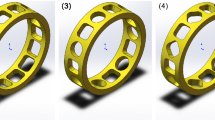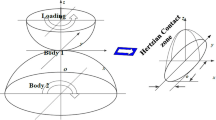Abstract
A motion model of adjacent rollers and a contact model between rollers and raceways were established to improve the Archard wear model, and the automatic discrete failure conditions of bearing without cage were studied by combining finite element and experiment. The results show that adjacent rollers produce discrete spacing when passing through the reducer raceway, and the automatic discrete failure depends on the wear depth of the reducer raceway. The wear depth is related to the wear times. The wear depth increases linearly with the increase of wear times to a certain extent. The discrete spacing generated by the reducer raceway is not enough to disperse the adjacent rollers. The experimental results show that the wear depth of reducer raceway increases with the increase of bearing operation time, and the error decreases with the increase of wear time. The theoretical calculation value is slightly larger than the experimental value, and the average error is within an acceptable range, which verifies the correctness of the automatic discrete failure model and the automatic discrete numerical simulation.
Similar content being viewed by others
Abbreviations
- F r :
-
Radial load
- ω i :
-
Internal angular velocity
- Θ :
-
Circumferential span angle of variable diameter raceway
- ΔΘ :
-
Discrete angle of two rollers
- p 1 :
-
Contact point 1
- p 2 :
-
Contact point 2
- ω m :
-
Rotary direction of rolling element
- ω b :
-
Rotation direction of roller
- ΔΥ :
-
Discrete distance
- Θ’:
-
The angle between the center distance of two balls when the rolling body is uniformly distributed
- Z :
-
Number of rollers
- D w :
-
Roller diameter
- D m :
-
Round diameter of bearing
- r c :
-
Variable contact radius
- h d :
-
Radial time-varying displacement
- ω m’ :
-
Rotary angular velocity of roller on variable diameter raceway
- t :
-
Motion time of roller
- Ø:
-
Angle between roller and z axis on variable diameter raceway
- L :
-
Length of variable diameter raceway
- B :
-
Width of variable diameter raceways
- β :
-
Ring angle of variable diameter roller
- α :
-
The circumferential angle between the center position of the variable diameter raceway and the contact point of the roller
- F c :
-
Centrifugal force
- G :
-
Gravity
- F n1 F n2 :
-
Normal contact force
- m :
-
Rolling mass
- ρ :
-
Density of rollers
- F f1 F f2 :
-
Sliding friction force
- v :
-
Slip velocity
- Δv :
-
Relative sliding velocity
References
W. Xi and Wang, Non-uniform contact behavior of wind turbine pitch bearing under working conditions, Bearing, 8 (2020) 8–12.
J. Yang, X. Li, H. Ou and Y. Ou, Contact stress analysis of main bearing of wind turbine based on finite length contact, Bearing, 2 (2020) 1–6.
J. Zhang, B. Fang, Y. Zhu, K. Yan and J. Hong, Calculation of load distribution and study of stiffness characteristics of ball bearings based on ball- raceway incomplete contact, J. of Mechanical Engineering, 56(9) (2020) 73–83.
J. Zhang, G. Chen, J. Xie, Z. He, C. Teng and Z. Cheng, Damage mechanics-finite element method for contact fatigue life prediction of ball bearings, Aerodynamics Report, 10 (2019) 2246–2255.
Empty Space Co., Ltd., Autonomous Distributed Rolling Bearing, http://coo-space.com/, Janpan.
V. G. Pavlov, Wear calculations for radial ball bearings, Russian Engineering Research, 28 (2008).
Y. Bai, P. Cao, Q. Gao, D. Huang and Y. Wu, Performance test of ceramic bearing grease lubricated attitude control flywheels for microsatellites, Optical Precision Engineering, 18(9) (2010) 2016–2021.
Y. Tanaka, H. Matsunaga, M. Endo and S. Moriyama, Micro-scale frictional behavior of a bearing steel (JIS SUJ2) in cyclic sliding motion, Procedia Structural Integrity, 19 (2019).
U. Olofsson, Fatigue life reduction due to wear in boundary lubricated spherical roller thrust bearings, Wear, 207 (1) (1997).
J. Zheng, S. Deng, W. Zhang and X. Dang, Atypical failure mechanism of aeroengine spindle roller bearings, J. of Aeronautics, 41(5) (2020) 305–317.
S. Ma, K. Yan, X. Zhang, M. Wang, Y. Zhu and J. Hong, Rolling bearing motion-contact accurate modeling and secondary development, J. of Xi’an Jiaotong University, 4(8) (2021) 1–7.
Z. Chen, Study on The Effect of Ball-raceway Contact Motion on The Fatigue Life of Raceways, Kunming University of Science and Technology (2020).
J. Zhu, H. Li, J. Fu and X. Liu, Fluid lubrication characteristics of aero-gear pump sliding bearing contact state, J. of Aerodynamics, 35(1) (2020) 169–177.
T. Zhang, X. Y. Chen, J. M. Gu and L. F. Zhao, Analysis of unstable motion mechanism of high-speed angular contact ball bearing cage, Vibration and Shock, 38(10) (2019) 233–241+268.
W. Wei, Y. Su, H. Fan, H. Liang, J. Song, Y. Zhang and L. Hu, Study of micro-motion frictional wear characteristics and damage behavior of silicon nitride ceramic balls and bearing steel, J. of Tribology, 3 (2021) 1–17.
S. Farrukh et al., Mechanical characterization of particulated FRP composite pipes: a comprehensive experimental study, Polymer Testing, 93 (2021).
J. Yang, Z. L. Xiao, J. Y. Deng, L. Q. Wang and X. Yang, Optimization of mechanical structure design of microturbulence generator based on numerical simulation of internal flow field, J. of Mechanical Engineering, 4(5) (2007) 127–132.
X. Yang, L. Ye, H. Hou and W. Yang, Comparative study on the characteristics and mechanism of erosion and wear of bridge piers with different shapes, Bridge Construction, 51(3) (2021) 47–55.
Z. Tang, H. Zhang, Y. Li and T. Zhang, Numerical calculation and analysis of two-dimensional cylindrical surface wear profiles under micro-motion wear conditions, Mechanical Design and Manufacture, 4(5) (2021) 34–39.
E. J. Ekoi, A. N. Dickson and D. P. Dowling, Investigating the fatigue and mechanical behaviour of 3D printed woven and nonwoven continuous carbon fibre reinforced polymer (CFRP) composites, Composites Part B, 212 (2021).
M. Van den Heever et al., Mechanical characterisation for numerical simulation of extrusion-based 3D concrete printing, J. of Building Engineering, 44 (2021).
G. D. Manolis et al., Mechanical models and numerical simulations in nanomechanics: a review across the scales, Engineering Analysis with Boundary Elements, 128 (2021) 149–170.
S. Gohari et al., Localized failure analysis of internally pressurized laminated ellipsoidal woven GFRP composite domes: Analytical, numerical, and experimental studies, Archives of Civil and Mechanical Engineering, 19(4) (2019) 1235–1250.
T. Hu, G. Yin and M. Sun, Research on the dynamic characteristics of spindle-bearing system based on centrifugal force and gyroscopic moment effect, Vibration and Impact, 33(8) (2014) 100–108.
J. Wang and G. Dong, Tribological Foundations, Xi’an University of Electronics and Technology Press, Xi’an, China (2018) 55–57.
Acknowledgments
This work was supported by National Natural Science Foundation (51875142, Research on automatic discrete mechanism of cageless ceramic ball bearing rolling body on local speed transformation surface), People’s Republic of China.
Author information
Authors and Affiliations
Corresponding author
Additional information
Yanling Zhao is Professor and doctoral tutor. Her main research directions are robot kinematics and dynamics, mechanical structure design and mechanical system dynamics.
Jingwei Zhang’s (Ph.D.) main research directions are mechanical structure design, robot kinematics and dynamics.
Rights and permissions
About this article
Cite this article
Zhao, Y., Zhang, J. & Zhou, E. Automatic discrete failure study of cage free ball bearings based on variable diameter contact. J Mech Sci Technol 35, 4943–4952 (2021). https://doi.org/10.1007/s12206-021-1013-2
Received:
Revised:
Accepted:
Published:
Issue Date:
DOI: https://doi.org/10.1007/s12206-021-1013-2




